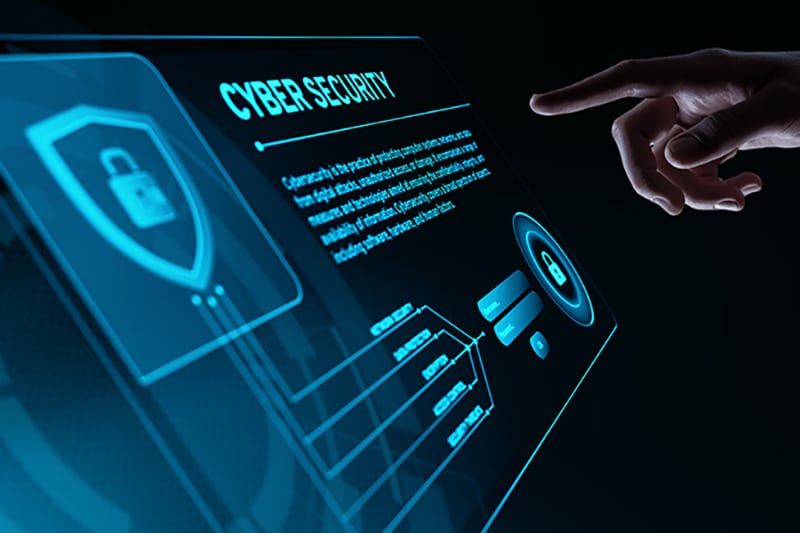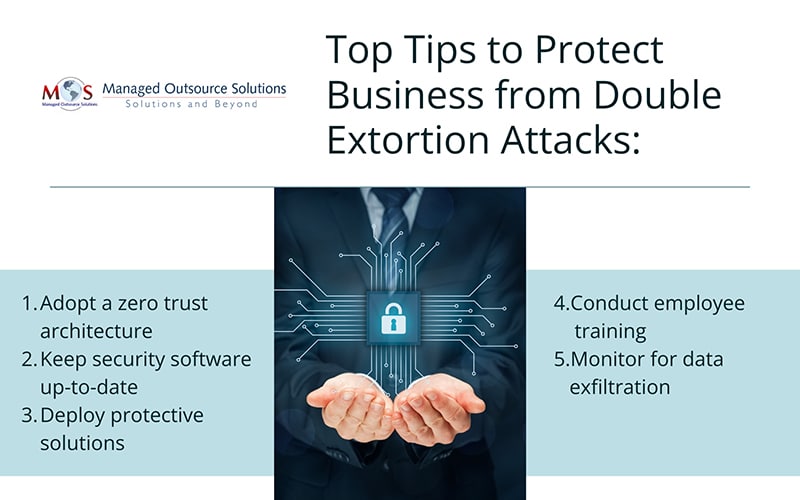Double extortion ransomware attacks are an advanced type of cyberattack in which a ransomware operator encrypts the victim’s data and denies access to their system until a demanded ransom is paid. Threat actors utilize various established techniques and methods to infiltrate the victim’s network and steal their data. Unlike traditional ransomware, this type introduces a new layer of threat: the threat actors also demand payment to prevent public release of the data unless a ransom is paid.
Although double extortion attacks can target any organization, companies that deal with more sensitive data, critical operations, and high revenue are at greater risk of these attacks. The industries listed below are especially more susceptible:
- Healthcare
- Finance
- Government and public sector
- Legal and law firms
- Tech and software companies
Business Process outsourcing services can play a pivotal role in mitigating the risk of ransomware attacks. By leveraging BPO expertise, advanced technology, and robust security practices, organizations can minimize the exposure of sensitive information and reduce the attack surface for cybercriminals.
Common Double Extortion Ransomware Methods Used by Attackers
Listed below are some of the common double extortion ransomware methods utilized by cybercriminals to infiltrate a system:
- Social engineering – Using social engineering methods such as phishing by sending fraudulent emails with malicious attachments or links, tricking users into downloading ransomware or revealing login credentials.
- Exploiting vulnerabilities – Taking advantage of unpatched software vulnerabilities, such as in operating systems, applications, or network devices, to infiltrate systems.
- Remote Desktop Protocol (RDP) Brute Force – Using brute force attacks or steal credentials to crack weak passwords on RDP services, which allow remote access to a system.
- Malware – Deploying malicious software to disrupt critical enterprise systems and steal valuable information or digital assets to extort large sums of money from businesses.
- Drive-By Downloads – Occurs when a victim unknowingly downloads ransomware simply by visiting a compromised website without actively clicking anything.
Double Extortion Attack Sequence
The typical sequence of a double extortion attack is as follows:
- Initial access: The threat actors use several techniques such as phishing email or malvertising to exploit vulnerabilities and gain initial access to the organization’s network.
- Lateral movement: Once inside, the attacker moves laterally through different parts of the infected network to locate and access higher-value targets such as business-critical files. They may also perform privilege escalation to acquire administrator credentials and control the entire network to maximize the impact of damage.
- Exfiltration: Before encrypting files, the attacker infiltrates sensitive information using advanced techniques such as SQL injection from the victim’s network. They employ obfuscation methods including compression or encoding to evade detection and move the exfiltrated data to remote sites.
- Encryption: The attacker deploys sophisticated ransomware that uses robust encryption algorithms to encrypt the victim’s files and holds the information hostage with a decryption key, effectively locking them out of the system.
- Ransom demand: A ransom note is sent, usually demanding payment in crypto currency, with a deadline to pay. In addition, they threaten to publicly expose or sell the stolen data on the dark web if the ransom is not paid.
Double Extortion Attacks: Potential Risks and After Effects on Business
A double extortion attack can have severe consequences and cause substantial damage to businesses, such as:
- Financial losses – Companies have to deal with heavy financial burdens and potential expenses in case of a successful attack resulting in ransom payments, recovery costs, and revenue loss.
- Reputational damage – The exposure of sensitive user information and interruption of services may cause customer churn, leading to the loss of customer trust, loyalty, and reputation for brands.
- Legal consequences – Businesses may incur legal penalties for failing to protect sensitive data and may face customer lawsuits for violating consumer protection laws.
- Operational disruption – The attack on critical systems and the threat of data leaks can severely disrupt business operations, resulting in downtime, lost productivity, delayed services, and competitive disadvantage.
- Impact on partnerships and contracts – If a company’s cybersecurity is compromised, it can potentially leading to lost partnerships and contracts.
How to Protect Your Organization from Double Extortion Attacks
As the double extortion attacks continue to evolve, they are becoming increasingly sophisticated to bypass strong cyber security measures implemented by companies. These attacks have grown more aggressive and dangerous, with enhanced tactics, including triple and quadruple extortions, used by threat actors. They can wreak havoc on businesses, causing severe damage to their operations and service disruption.
A multi-faceted approach of investing in resilient cyber security protocols and diligent response plans is the optimal solution. Here are the best practices to follow to protect your organization against cyberattacks:
- Zero trust architecture – As successful double extortion attacks depend on access control, adopt a zero trust policy within your organization. This requires all users, applications, websites, emails, and links to be authorized and authenticated before gaining network access. This framework relies on the three principles of minimizing attack surface, limiting lateral movement, and continuous monitoring of all networks.
- Keep security software up-to-date – Ensure that all your software and computer systems are updated with the latest security patches and verify that antivirus software is up to date to mitigate vulnerabilities. Regularly strengthen security against phishing attacks and set up multiple recovery plans and backups for added layers of protection.
- Deploy protective solutions – Deploy robust anti-ransomware solutions with real-time and continuous monitoring to thwart threats in real-time to prevent infection. These solutions are capable of detecting anomalies in user activities, providing quick response and remediation options to mitigate potential cyber breaches. Leverage threat intelligence feeds to track changes to critical files, alerting admins to suspicious alterations.
- Conduct employee training – Conduct regular cybersecurity awareness training for employees, focusing on identifying phishing emails and malicious attachments, which are common methods for initiating ransomware attacks. Implement a clear process for reporting suspicious activity. Prompt detection can prevent an attack from spreading.
- Monitor for data exfiltration – Monitoring for data exfiltration is crucial to prevent double extortion attacks. By implementing tools such as Data Loss Prevention (DLP), you can track and restrict the movement of sensitive information across your network. Also consider using services that monitor the dark web for your organization’s data, enabling you to quickly detect if sensitive information is being compromised or sold.
Stay Protected Against Ransomware Attacks
As businesses manage ever-growing volumes of data, the stakes of data breaches have escalated dramatically in the digital age, with severe financial, legal, and reputational consequences. The increasing reliance on digital platforms amplifies the risks, making robust cyber security essential for protecting sensitive information.
By partnering with a reliable BPO outsourcing company, businesses can minimize their exposure to ransomware threats while focusing on their core operations. These companies typically utilize advanced cybersecurity measures, including firewalls, encryption, and intrusion detection systems, reducing the likelihood of ransomware infiltrating systems. They monitor networks continuously, identifying and mitigating potential threats before they escalate into attacks.
You might be interested in: How to Prevent Ransomware Attacks





